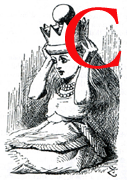[Thanks to James Heffernan, founder and editor-in-chief of Review 19 for sharing this review with readers of the Victorian Web. The illuminated “C” is based on John Tenniel's illustrations for the Alice books — George P. Landow.]

hristine Krueger has previously published The Reader's Repentance: Women Preachers, Women Writers and Nineteenth-Century Social Discourse (Chicago, 1992) and Functions of Victorian Culture at the Present Time (Ohio, 2002). Her new book is a solid and erudite contribution to the realm of literature and law from the perspective of literary and legal history: a book aimed at deepening scholarly work on historiographies and literary texts about witchcraft, the evolution of the Reasonable Man standard of evidence in lunacy inquiries, defense strategies for trials involving indecent assault and sodomy, advocacy for female prisoners, and the fate of female witnesses and pro se litigants between 1789 and 1914, the "long nineteenth century." She offers illuminating, if at times dense, readings of legal documents on witchcraft, infanticide, indecent assault, lunacy and sodomy prosecutions, as well as studies of such texts as Elizabeth Gaskell's Lois the Witch, Mary Barton, North and South and Ruth; Reginald Scot's skeptical critique called The Discoverie of Witchcraft; George Eliot's Adam Bede and Felix Holt; Charles Reade's Griffith Gaunt, Hard Cash and It's Never too Late to Mend; Sir Walter Scott's The Heart of Mid-lothian; and Mary Wollstonecraft's Maria: or, The Wrongs of Woman and A Vindication of the Rights of Women.
To make her case, and to challenge influential studies of literature and law made by Richard Posner in particular, she develops sophisticated arguments invoking Jürgen Habermas, Michel Foucault, and a range of crucial theorists of the relation between literature and law, notably Robin West. For the sake of contemporary legal advocacy, Krueger aims to show the connections between literature-and-law theory and historical legal scholarship. The gap between the two, she writes, "handicaps legal scholars" who wish to make "nuanced and defensible claims about the literary examples they draw from the past" (2). Stressing the "and" in the "literature and law" compound, she questions the polarizing tendency to set up the authoritative black letter law and its rule-bound practices against storytelling or fiction. In this regard, she contributes to "outsider law," an important feminist and racially-sensitive approach to the law that has been described and critiqued by, amongst others, Anne Coughlin and Mari Matsuda. Seeking in multidisciplinary ways a kind of justice that moves beyond the application of existing legal texts, she aims to show how reading literature as well as legal texts for the sake of law can serve the common good.
Since Krueger is chiefly occupied with the representation and articulation of "deviance," she examines current work on "rationality and emotion, objectivity and empathy, empiricism and constructivism, propositional and narrative reasoning in law" (4-5). Along the way, she takes up debates over feminist epistemology, postmodern law, aestheticization, agency, cultural studies, historicism, and storytelling. As a consequence, this work should not only interest students of the relation between literature and law (particularly for nineteenth-century work); it should also appeal to anyone who wants to see how a field such as law, which is too often considered autonomous or self-referential, can be irradiated by texts and methods drawn from another field. By juxtaposing methods drawn from history, literary study, and the realm of law, Krueger demonstrates that "reading for the law" demands patience and erudition, in equal and significant measure.
For this very reason, she treats neither law nor literature as the source of a definitive methodology on topics such as gender advocacy. Even if, for instance, Elizabeth Gaskell's Lois the Witch can tell a revealing story about traumatic experience, it needs to be read as critically as legal texts, rather than as some kind of an ideal or antidote to them. Gaskell herself would seem to agree. "Her version of realism," Krueger writes, "... exhibits not only the powers of literature for gender advocacy but also its political limitations" (51). Throughout the book, this kind of insight is applied in equal measure to legal testimony and storytelling. While fictionalized, biographical, or personal testimony can at times excite a reader's sympathy, Krueger makes it clear that this does not always happen. Literature and legal argument each has its power and its limitations, and even within the same chronotopes, the reader's reaction may be unpredictable. Consequently, in judging the potency of agency, evidence, and motive in the history of witchcraft prosecution, she finds them "problematized not by a transhistorical structure of difference, but by gender operating within a dynamic of literary political and social forces that demand careful attention to historical specificity and the construction of historiographic consciousness within print culture" (98).
In laying out its valuable methodology for studying literature and law in tandem, this complex work challenges its readers to be as careful and rigorous as the author herself.
Bibliography
Krueger, Christine. The “Reading for the Law: British Literary History and Gender Advocacy . Virginia, 2010. xi + 301 pp.
Last modified 22 June 2014